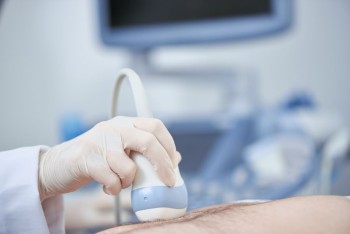
Doppler Arterial examination of both upper limbs is a diagnostic procedure aimed at assessing blood flow in the arteries supplying the arms.
Doppler Arterial Both Upper Limbs in India with Cost
Doppler Arterial Both Upper Limbs in Detail
Introduction
Doppler Arterial examination of both upper limbs is a diagnostic procedure aimed at assessing blood flow in the arteries supplying the arms. Utilizing Doppler ultrasound technology, this non-invasive test provides detailed images, enabling healthcare professionals to evaluate the circulation and identify potential vascular issues in both upper extremities.
Understanding the
Procedure
Doppler Ultrasound Technology
Doppler ultrasound involves emitting high-frequency sound waves into the body and analyzing the echoes as they bounce off moving blood cells. For Doppler Arterial Both Upper Limbs, the focus is on the arteries, assessing blood flow patterns and detecting abnormalities.
Application to Both Upper Limbs
This procedure specifically targets the arteries supplying blood to both arms. It is often employed to diagnose conditions such as atherosclerosis, arterial stenosis, or other vascular disorders affecting the upper extremities.
Procedure Walkthrough
Before the test, patients are usually instructed to wear loose clothing. A gel is applied to the skin over the targeted arterial areas, and a handheld transducer is used to capture real-time images. The procedure is painless and well-tolerated by most patients.
Interpretation of Results
Reading and Analyzing Doppler Ultrasound Images Healthcare professionals carefully interpret the acquired images, focusing on blood flow velocities, identifying any signs of blockages, or abnormalities in the arteries of both upper limbs. The results are crucial for an accurate diagnosis.
Clinical Significance
The results of Doppler Arterial Both Upper Limbs hold clinical significance in diagnosing various vascular conditions affecting the arms. This includes conditions like arterial thrombosis, aneurysms, or other disorders that may compromise blood flow.
Indications and
Applications
Medical Conditions Addressed
Doppler Arterial examination of both upper limbs is indicated in a range of medical conditions affecting arterial health. This includes but is not limited to, identifying peripheral artery disease (PAD), assessing the risk of blood clots, or detecting arterial abnormalities.
Contribution to Diagnosis
The procedure significantly contributes to the accurate diagnosis of vascular disorders in both upper limbs. It aids healthcare professionals in formulating appropriate treatment plans based on the specific arterial condition identified.
Benefits and Limitations
Advantages of the Procedure
One of the primary advantages is its non-invasiveness. Doppler Arterial Both Upper Limbs provides immediate imaging, allowing for prompt assessment and facilitating timely intervention. Additionally, it is patient-friendly compared to invasive procedures like angiography.
Limitations and
Considerations
While highly effective, the procedure may face challenges in cases where imaging quality is compromised. Understanding these limitations is crucial for healthcare professionals, prompting consideration of alternative imaging modalities when necessary.
Importance in Vascular Health
Role in Overall Arterial Health Assessment
Doppler Arterial Both Upper Limbs plays a crucial role in the overall evaluation of arterial health. Early detection of potential issues allows for timely preventive measures, reducing the risk of complications associated with vascular diseases affecting the arms.
Incorporation into Treatment Plans
The information gathered through this procedure is instrumental in devising personalized treatment plans. It guides healthcare professionals in choosing the most appropriate interventions based on the specific arterial conditions identified in both upper limbs.
Conclusion
In conclusion, Doppler Arterial examination of both upper limbs stands as a valuable and non-invasive tool in assessing arterial health affecting the arms. Its accurate and real-time imaging capabilities make it indispensable in diagnosing and managing various vascular conditions in both upper extremities.
Frequently Asked Questions (FAQs)
1. Is Doppler Arterial Both Upper Limbs a painful procedure?
No, the procedure is non-invasive and generally well-tolerated by patients. It involves the use of ultrasound waves and does not cause any discomfort.
2. How long does the procedure take for both upper limbs?
The duration of the test varies but typically takes around 30 to 60 minutes. Factors such as the complexity of the case and the patient's anatomy can influence the time required.
3. Can this procedure be performed on pregnant individuals?
While generally safe, healthcare providers may consider alternative methods or postpone the test unless it is deemed necessary for medical reasons.
4. Are there any risks associated with Doppler Arterial Both Upper Limbs?
The procedure is considered safe, with minimal risks. It does not involve radiation exposure or the use of contrast agents, reducing potential complications.
5. How often should individuals undergo Doppler Arterial Both Upper Limbs screening?
The frequency of screening may vary based on individual health conditions and risk factors. It is advisable to consult with healthcare professionals for personalized recommendations.
6. Can Doppler Arterial Both Upper Limbs detect
conditions other than arterial blockages?
Yes, besides arterial blockages, the procedure can detect various arterial conditions, including aneurysms, arterial thrombosis, and abnormalities affecting blood flow to the upper limbs.
7. Is there any specific preparation required before undergoing Doppler Arterial Both Upper Limbs?
While specific preparations may vary, patients are generally advised to wear loose and comfortable clothing. It's essential to inform the healthcare provider about any medications or allergies before the test.
8. Can this procedure identify the risk of blood clots in the arteries of both upper limbs?
Absolutely. Doppler Arterial Both Upper Limbs is effective in identifying the risk of blood clots and assessing the overall arterial health of the upper extremities.
9. Is Doppler Arterial Both Upper Limbs suitable for individuals of all
age groups?
Yes, the test is applicable to individuals of all age groups and is commonly used to assess arterial health in both young and elderly patients.
10. Are there any alternatives to Doppler Arterial Both Upper Limbs for evaluating arterial health?
While Doppler Arterial Both Upper Limbs is highly effective, other imaging modalities, such as magnetic resonance angiography (MRA) or computed tomography angiography (CTA), may be considered based on specific clinical requirements.
11. How soon can patients resume normal activities after Doppler Arterial Both Upper Limbs?
Patients can generally resume normal activities after the procedure. There is no downtime associated with Doppler Arterial Both Upper Limbs.
12. Can the test be used for monitoring ongoing treatments for arterial conditions?
Yes, besides its diagnostic role, Doppler Arterial Both Upper Limbs is valuable for monitoring the effectiveness of treatments and making necessary adjustments as needed.
13. Does the procedure pose any risk of radiation exposure?
No, Doppler Arterial Both Upper Limbs does not involve radiation exposure, making it a safe imaging modality for assessing arterial health in the upper extremities.
(0)
Login to continue



